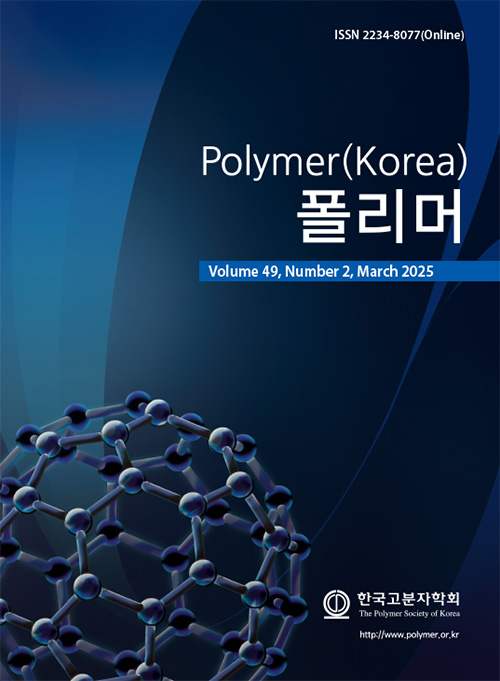- Synergistic Effect of ZnO/Chitosan Nanocomposite on the Photostability Enhancement of Polyvinyl Chloride
Nibras Abdul-Ameer Aboud, Khawla Kareem*, Ali J. Al-Sarray**,†
 , Basma Esam Jasim, Shaimaa B. Al-baghdadi***, and Ahmed A. Ahmed**
, Basma Esam Jasim, Shaimaa B. Al-baghdadi***, and Ahmed A. Ahmed**Department of Chemical Industrial, Institute of Technology/Baghdad, Middle Technical University, 10074 Iraq
*Ministry of Education, Directorate of Rusafa-2, Baghdad, 10064 Iraq
**Polymer Research Unit, College of Science, Mustansiriyah University, 10052 Iraq
***Energy and renewable Energies Technology Center, University of Technology, 10066 Iraq- 폴리염화비닐의 광안정성 향상에 대한 ZnO/키토산 나노복합체의 시너지 효과
Reproduction, stored in a retrieval system, or transmitted in any form of any part of this publication is permitted only by written permission from the Polymer Society of Korea.
This study investigates the enhancement of poly(vinyl chloride) (PVC) properties through the incorporation of zinc oxide (ZnO) nanoparticles and chitosan to improve its resistance to UV-induced photodegradation. The nanocomposites were synthesized by blending ZnO and chitosan with PVC, followed by comprehensive characterization using X-ray diffraction (XRD), field emission scanning electron microscopy (FE-SEM), atomic force microscopy (AFM), and Fourier transform infrared (FTIR). XRD confirmed the crystalline structure of ZnO-chitosan nanoparticles with a crystal size of 25.38 nm, while FE-SEM analysis revealed an average grain size of 76.68 nm, indicating the successful formation of nanoscale materials. AFM demonstrated a significant reduction in surface roughness and photodegradation in the nanocomposite films compared to pure PVC. FTIR analysis revealed lower photodegradation indices (IPO, ICO, IOH) in the nanocomposites across UV irradiation durations of 0, 50, 100, 150, 200, 250, and 300 h, indicating a delayed formation of carbonyl and hydroxyl groups. Weight loss and viscosity measurements further confirmed enhanced UV stability, attributed to the synergistic effect of ZnO's UV-shielding properties and chitosan's radical-scavenging capabilities. These results highlight the potential of ZnO-chitosan nanocomposites to significantly extend the service life of PVC in harsh environments.
Keywords: nanocomposites, poly(vinyl chloride), photodegradation of poly(vinyl chloride), zinc oxide, chitosan.
- Polymer(Korea) 폴리머
- Frequency : Bimonthly(odd)
ISSN 2234-8077(Online)
Abbr. Polym. Korea - 2024 Impact Factor : 0.6
- Indexed in SCIE
 This Article
This Article
-
2025; 49(2): 246-252
Published online Mar 25, 2025
- 10.7317/pk.2025.49.2.246
- Received on Oct 28, 2024
- Revised on Dec 6, 2024
- Accepted on Dec 8, 2024
 Correspondence to
Correspondence to
- Ali J. Al-Sarray
-
Polymer Research Unit, College of Science, Mustansiriyah University, 10052 Iraq
- E-mail: ali_alsarray@uomustansiriyah.edu.iq








 Copyright(c) The Polymer Society of Korea. All right reserved.
Copyright(c) The Polymer Society of Korea. All right reserved.